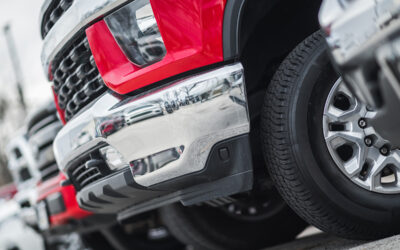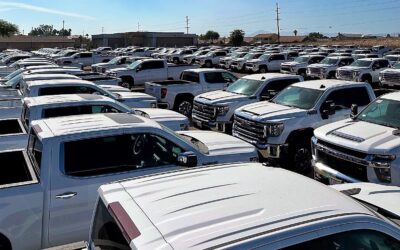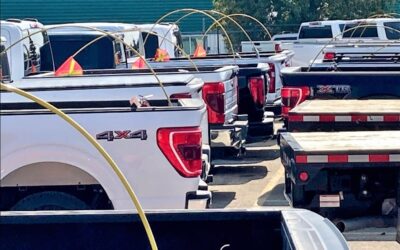Fleet Management in Non-Traditional Fleets
Fleet managers generally concern themselves with three key items: 1) vehicle availability 2) vehicle/fleet maintenance 3) operator/driver-related issues. To properly manage these three priorities, fleet managers and those that work for them must closely administer drivers, maintenance, and vehicles on a daily basis. By augmenting traditional fleets with rental vehicles, managers can lower or at a minimum standardize a portion of their operating costs and improve vehicle availability allowing managers to meet operational demands, control costs, better maintain company owned vehicles, and enhance operator management.
Vehicle Availability and Maintenance
Managers of traditional, company-owned commercial fleets must constantly balance the demand for fleet assets and vehicle availability while continuing to meet requirements for preventive and corrective maintenance to keep the fleet at the best, most work-ready condition possible. Maintenance down time, labor, parts, storage, and depreciation can all add up and, depending on the type, frequency, and severity of maintenance and repairs, may take on a life of their own.
Aside from fuel, the costs linked to maintaining a mission-ready fleet of vehicles can be significant—and time consuming. Throw in factors such as the age of vehicles, operator driving habits, and operating environment and fleet managers can find themselves behind the eight ball operationally with increasing operating costs and nothing to show for it on the availability and readiness side of the ledger.
The constant ebb and flow between operating requirements and the absolute necessity for preventive/corrective maintenance can quickly turn into a flood of broken trucks if not closely managed. Additional pressure from company leadership to keep a lid on the costs associated with preventive and corrective maintenance can also undermine the best of programs and intentions in favor of short term gains in the bottom line.
Lastly, a fast-paced, short-fuse operating climate where vehicle availability drives productivity (and profitability) generally reduces the time allowed for maintenance which can adversely impact vehicle availability. In this scenario where maintenance becomes an afterthought or takes a back seat to operational needs, fleet managers can quickly find themselves in a no-win situation where the number of vehicles in the maintenance cycle exceeds the number available for operations.
In a non-traditional fleet comprised of a mixture of company-owned vehicles, leased units, and rented vehicles, managers have the added option of augmenting their fleets with newer, temporary inventory to meet short-fuse requirements or to gain traction on its in-house maintenance efforts. Where traditional fleet managers may run vehicles for several years, the non-traditional approach infuses the company-owned fleet with new, clean, and warrantied vehicles to continue to meet operational demands and address internal maintenance challenges.
The newer inventory will have significantly fewer maintenance issues, improved emissions and gas mileage, and be under warranty should something come up maintenance-wise. Further, these newer vehicles can also have the added benefit of leveling out or even reducing escalating operating costs associated with maintaining aging fleets. In addition to providing managers improved availability and some breathing room for maintenance, the influx of new vehicles, in many cases, may also provide access to the latest technology further benefiting fleet managers.
Operator Challenges
One of the most demanding areas in fleet management is driver or operator management, specifically managing operator driving habits. Done properly, this particular aspect of fleet management can pay huge dividends in lowering operating costs, reducing maintenance down time, and improving vehicle readiness and availability rates. Ignored or done poorly, the negative impact can be a show-stopper. To meet this challenge and move it to the “done right” category, fleet managers should aggressively pursue the tools and policies necessary for success. Translation: invest in technology and training and replace those operators that fail to meet expectations both on the road and in the classroom. It wasn’t too long ago that when a vehicle left the lot, managers had no way of knowing where it was at any given time, how fast it was going, or how long it was idling unless the vehicle was involved in an accident, caught speeding, or observed at a place it wasn’t supposed to be.
In fleets of mixed company, leased, and rented vehicles, having the ability to refresh or augment the fleet with new vehicles with the latest technology helps managers address many of the challenges associated with proper driver management. With today’s technology, fleet managers are limited only by their imagination—and budgets—in monitoring and proactively influencing driver behavior. Telematics, whether standard OEM provided hardware and systems or vendor installed after-market systems, provide managers usable, tailor-able vehicle and driver behavior reporting in real time. Want to see where a vehicle is, where it’s been, how long it has idled, where it idled or how fast it is going or has gone? Get on your computer or smart phone and point and click. Need to re-direct a driver to a higher priority location or customer? Point and click. Want to monitor your fleet locations in the middle of the night, while on travel, or from home? Get out your smart phone or tablet and make it happen.
The detailed, usable, real time information managers need to monitor operations, redirect assets to meet emergent short fuse requirements, or influence driver behavior is literally at their fingertips. Better yet, the technology’s capabilities are improving continuously and the associated costs are becoming more competitive as more service providers enter the market. Implementing this type of driver/vehicle management solution can have a noticeably positive impact on driver behavior and ultimately improve the cost structure associated with this particular fleet management area.
Non-Traditional Fleet
While managers of traditional, company-owned and maintained fleets focus on the areas previously discussed, fleet management teams of all-rental fleets concentrate their efforts in two central areas: new inventory management and off-rent actions. These inter-related areas drive much of the planning and operations within these unique fleets.
Unlike traditional fleets that may run vehicles for years, all-rental fleets will turn over its inventory each year or after each project—ordering the latest model trucks annually and turning in 1-year-old or older inventory when they come off rent. While this can create self-inflicted challenges if not planned for and managed properly, this approach provides new, warrantied, low maintenance trucks that are ready for work on day one. Additionally, in this type of fleet, vehicle availability is driven by new truck orders and deliveries, in-house operations forecasts, and the anticipated location of vehicle demand. While this requires constant monitoring of current and expected demand, fleet management can work with rental vehicle and their logistics planners to meet requirements, minimize out-of-position inventory, and meet project start times and operating costs.
Managers of company-owned, operated, and maintained fleets overcome a variety of challenges on a daily basis to keep their fleets rolling. To help meet these situations and perhaps reverse temporary shortfalls in availability or maintenance, managers may turn to non-traditional options such as rental vehicle augmentation. By supplementing their fleets with new, clean, and warrantied vehicles, fleet managers can improve readiness and availability, address maintenance challenges, and enhance operator management while providing the means to meet both long and short term operational demands.






